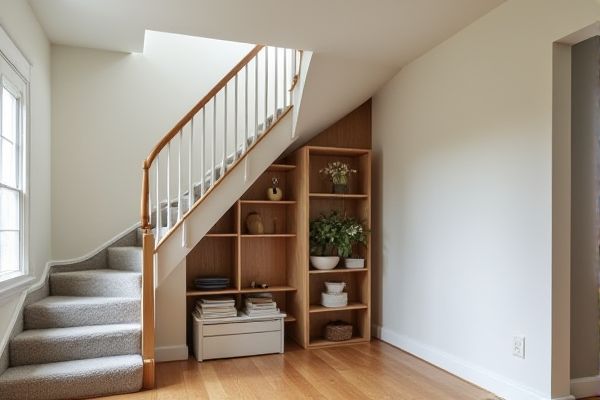
Under-stair storage offers concealed compartments to maximize space efficiently, while open under-stair designs create an airy, accessible area that enhances room aesthetics. Discover which option best suits Your home's needs and style by reading the full article.
Table of Comparison
| Feature | Under-Stair Storage | Open Under-Stair |
|---|---|---|
| Functionality | Closed compartments for organized storage | Open space enhancing visual openness |
| Use Case | Storage for shoes, books, cleaning tools | Decorative display, seating, or plants |
| Design Style | Concealed and minimalist | Modern, airy, and casual |
| Space Efficiency | Maximizes hidden space usage | Maintains openness, less storage capacity |
| Installation Cost | Moderate to high, depends on cabinetry | Low to moderate, simple construction |
| Maintenance | Requires cleaning inside compartments | Easy to clean, dusting open surfaces |
| Visual Impact | Neat, hidden clutter | Showcases architectural detail |
Maximizing Under-Stair Space Efficiency
Under-stair storage with built-in cabinets or drawers maximizes space efficiency by utilizing every inch for organized storage, reducing clutter and increasing functionality. Open under-stair areas offer flexibility for decorative displays or seating but may sacrifice enclosed storage capacity and dust protection. Customizable solutions blend both approaches, optimizing accessibility and maximized use of the otherwise wasted under-stair void.
Aesthetic Appeal: Closed vs Open Under-Stair Designs
Closed under-stair storage offers a sleek and streamlined aesthetic by concealing clutter and maintaining clean lines, making spaces appear more organized and minimalist. Open under-stair designs contribute to a sense of spaciousness and architectural interest by showcasing decor or functional elements, enhancing visual depth and character. Choosing between closed and open under-stair solutions directly impacts the overall room ambiance, balancing between neatness and decorative openness.
Storage Capacity: Which Option Holds More?
Under-stair storage offers significantly more capacity by utilizing enclosed spaces such as cabinets, drawers, or closets, maximizing every inch for efficient organization. Open under-stair areas provide limited storage, typically suited for decorative items or small open shelves, but lack the ability to securely hold larger or numerous items. Your choice depends on whether you prioritize high-capacity, concealed storage or aesthetic, open display beneath the stairs.
Accessibility and Convenience Considerations
Under-stair storage offers enclosed compartments that maximize space efficiency while keeping belongings hidden, enhancing room tidiness. Open under-stair designs provide immediate visibility and easy access, ideal for frequently used items or displaying decor. Your choice depends on whether you prioritize concealed organization or quick, convenient accessibility.
Clutter Control: Hidden Storage versus Open Display
Under-stair storage offers superior clutter control by concealing items behind doors or drawers, creating a streamlined and organized appearance. In contrast, open under-stair areas function as display spaces, which can showcase decorative items but may contribute to a more visually busy environment. Choosing hidden storage optimizes space efficiency and reduces visual distractions, ideal for maintaining a tidy home.
Customization Options for Under-Stair Areas
Under-stair storage offers extensive customization options such as built-in shelves, drawers, and cabinets tailored to fit various household needs and dimensions, maximizing space efficiency. Open under-stair designs emphasize flexible, modular components like adjustable shelving and open cubbies that accommodate frequently used items while maintaining an airy aesthetic. Both approaches can integrate smart storage solutions, including pull-out baskets and hidden compartments, enhancing functionality and organization.
Versatility of Closed and Open Under-Stair Uses
Closed under-stair storage offers versatile solutions for decluttering, providing hidden compartments for items like shoes, cleaning supplies, or seasonal decorations that keep spaces tidy and organized. Open under-stair designs serve multifunctional purposes by creating display areas for books, plants, or decorative objects, enhancing aesthetic appeal while maintaining accessibility. Both options maximize underutilized space, with closed storage emphasizing concealment and organization, and open storage promoting visual openness and easy access.
Cost Comparison: Building Closed vs Open Under-Stair
Closed under-stair storage typically involves higher costs due to materials, labor for installing doors or panels, and potential custom shelving, while open under-stair designs are more budget-friendly with simpler construction and less finishing work. The cost difference can vary depending on the choice of materials such as wood, MDF, or metal, with closed units often requiring additional hardware and paint or stain. Your decision should weigh the investment against functionality and aesthetics, as closed storage offers a tidy, concealed space while open shelving provides easy access and a modern look.
Maintenance and Cleaning Requirements
Under-stair storage units typically require more maintenance due to enclosed spaces that can accumulate dust and moisture, necessitating regular wiping and ventilation checks. Open under-stair designs allow easier access for cleaning, reducing dust buildup and making it simpler to detect and address any dirt or cobwebs promptly. Choosing between these options impacts long-term upkeep, where enclosed storage demands periodic deep cleaning, while open spaces favor low-maintenance routines.
Best Uses: Choosing the Right Under-Stair Solution
Under-stair storage maximizes space with concealed compartments ideal for tidying clutter, seasonal items, or household essentials. Open under-stair designs work best for displaying decorative items, books, or creating a cozy nook that enhances your living area's aesthetic. Assess your storage needs and lifestyle to determine whether functionality or visual appeal takes precedence in Your home.
 homyna.com
homyna.com